Replacing the socket in the apartment with your own hands
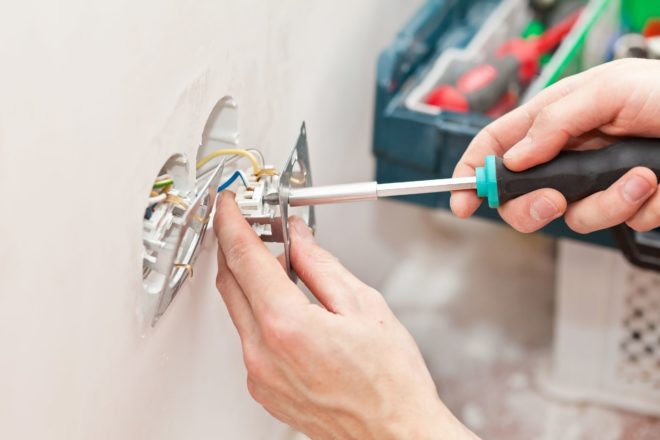
To learn how to change the outlet, you just need to do it once. There are nuances associated with the installation of grounding contacts or the installation of new devices instead of old Soviet ones, but there are no big difficulties in how to replace the outlet, the main thing is not to forget to turn off the electricity in the apartment or house.
Content
Required tools and materials
To do all the work without being distracted by finding the right tools, you should prepare everything in advance. To simply replace the outlet with your own hands you will need:
- Voltage indicator - one or two-pole.
- Screwdrivers - Phillips and flat.
- Pliers with wire cutters (or separately).
- A knife - even the smallest will do.
If the question is how to change the old-style outlet to a new one, then you will additionally have to prepare the following:
- A socket that fits the new device.
- Drill with a drill for the wall.
- Hammer and chisel.
- Plaster or other putty.
This is a necessary and sufficient set of tools to replace the socket yourself.
Dismantling the old socket
The most difficult case is considered to be the repair of an old-style socket, when it changes to a new one together with an old iron socket, instead of which a plastic one is installed. If you understand how to change such an outlet yourself, then in all other cases it will be much easier to act. In general, the whole procedure boils down to the step-by-step execution of individual stages, before which you must first check the presence of voltage on the contacts (to make sure that only a replacement is needed, and not repairs), then turning off the input circuit breaker and again check the terminals with a voltage indicator (to make sure that the circuit breaker has worked).
Removing the cover
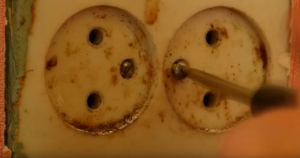
Depending on whether the single socket is changing, double or triple, the cover is held on one two or three bolts. If in old devices the lid structure is monolithic, then in modern devices it consists of two parts - a decorative frame and the lid itself, which covers the live parts.
When removing the cover, there may be the following nuances:
- Bolts rotate, but not loosened due to stripped threads. In this case, you need to help them by pulling the cover away from the wall. If there are two bolts, then you need to unscrew them a little, while alternately pulling the top or bottom of the cover.
- The lid or decorative strip can "stick" to the wallpaper - especially often in the kitchen, due to high humidity. With a strong jerk, such a cover can tear off a good piece of wallpaper or paint from the wall after it. How to properly tear it off the wall without consequences must be decided in each case in different ways. For example, you can carefully separate the lid from them with a knife.
Dismantling the interior
Depending on the model of the socket, its inner part can be held on spacer lugs, screwed to the socket, or attached directly to the wall with dowels. The last option is rare: mostly the first and second come across - separately or together.
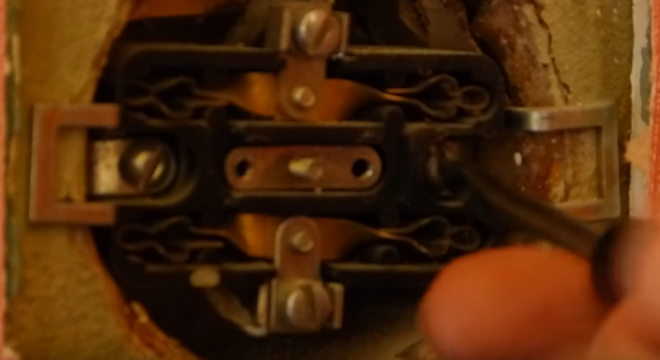
In any case, it is easy to find the fasteners - you either need to look for the bolts around the perimeter of the socket box or look at the spacer antennae with which the device touches the wall, trace what bolts they are tightened with and unscrew them. Usually, two or three turns are enough for the fasteners to loosen and the inner part falls out of the socket, or rather, hangs on the wires, which must also be unscrewed.
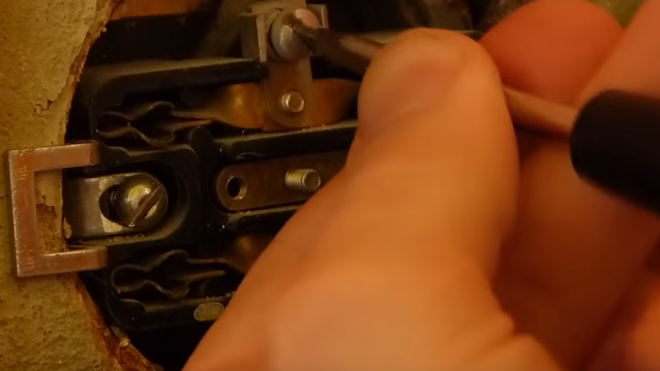
The wires themselves can be two or three, if there is grounding. To remove them, you need to unscrew the mounting screws. If the network has a ground wire, then it may be laid differently than the rest of the wiring. The PUE recommends using a solid wire for grounding, therefore a conductor on which a loop is made can come to the outlet and the same wire will go back to another point. It is impossible to violate its integrity - this will affect the quality of grounding.
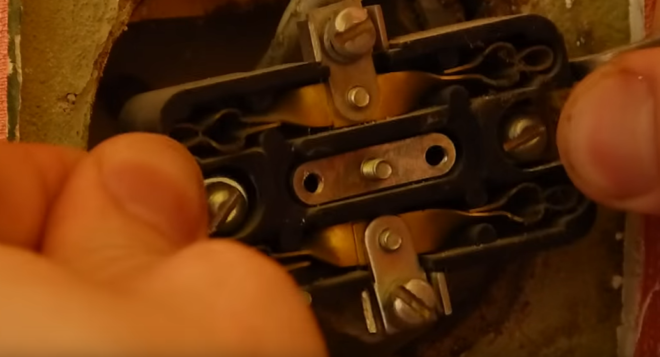

How to dismantle the outlet and install a new one in the old socket box, see this video in more detail:
Replacing the socket
This is not an obligatory step - if the new socket fits the old socket, then it is not necessary to change it. Usually, a replacement is needed if an iron socket is installed in the wall, on which the spacer legs of new sockets, made of soft metal, will slide.
You can remove the old socket in two ways - deform (bend) it with pliers and pull it out, or drill holes around it with a drill and gently knock it out of the wall.
Then the hole is cleaned out so that it is slightly larger in diameter than the new socket. If it does not fit, then the hole is widened with a hammer and chisel. If the depth is insufficient, then you can deepen the hole itself or cut off a new socket. It is necessary to ensure that it is installed flush with the wall surface.
To install it into the wall, the mounting hole and the outer part of the socket box are coated with putty and it is recessed into the wall (at the same time, wires must be threaded into it). When the putty has hardened, further installation is carried out.
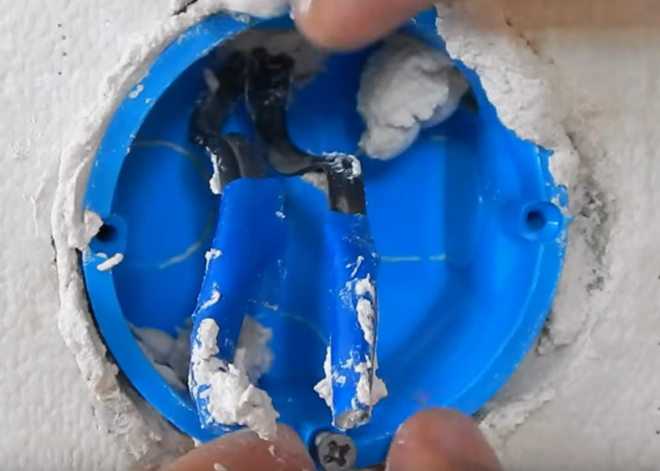
When you replace the socket with your own hands in the wall, on which expensive wallpaper is already glued or for some other reason there is a fear of damaging it, then the socket can be screwed with dowels. In this case, it is necessary to drill holes for them obliquely in different directions.
If the socket box changes, even if the input machine is de-energized, it is advisable to wrap the bare ends of the wires with electrical tape so that dust or putty does not settle on them.
For details on replacing the outlet and socket, see this video:
Installing a new socket
All operations are performed in the reverse order, but with a new socket. Before installation, you need to pay attention to the wire - if there was poor contact in the old outlet, then the core could heat up during operation - if the insulation has lost its plasticity, then at least it is required to remove it, and put on top of the core a cambric, heat-shrinkable film or wrap with electrical tape.
If the wire is aluminum, then with frequent overheating it becomes brittle and a break in the core itself is possible - in this case, it will have to be increased.
When the putty around the socket hardens and everything is in order with the wire, then you can proceed to further installation.
Securing the wires

It is considered a good form among electricians to "hang" the phase on the right, and zero on the left terminal of the socket, if you stand facing it. If you screw the wires the other way around, nothing happens. The conductors are stripped, inserted into the terminals and tightened in the fasteners. Such a stripping of the core is considered correct when its inner wire protrudes from the terminal by no more than 2-3 mm.
Before fastening the wire, check that all terminals are dry and clean. Make sure that there is good contact between the exposed part of the wire and the socket, and that the bolt is tightened securely. Otherwise, over time, the contact will begin to overheat and the wire may burn out.
Installing the socket into the socket
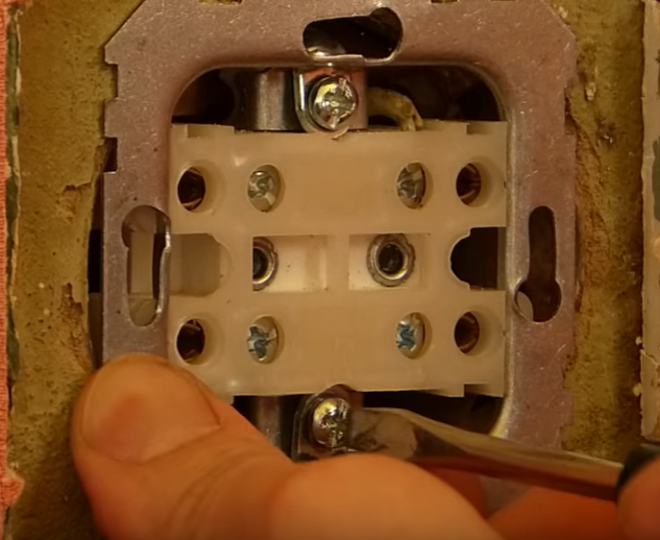
Depending on the type of socket, it will be fastened with spacers, bolted connections or dowels. When it is wound up inside the socket, then it is necessary to hold the spacer legs, since in a free state they stagger freely and sometimes prevent the outlet from completely entering the mounting hole.
To prevent this from happening, they are fixed with a regular clerical rubber band, which will hold them pressed against the outlet, but will not interfere with its fixing in the socket.
Additionally, you can fasten the socket with bolts, just make sure that the mounting holes coincide with those on the socket.
Dowels are used only if, for some reason, the fastening cannot be performed in any other way. Not all models have mounting holes for this, so there is a high probability that you will have to look for a suitable one before replacing the outlet. Holes for dowels are drilled in the wall obliquely in different directions.
Completion of installation
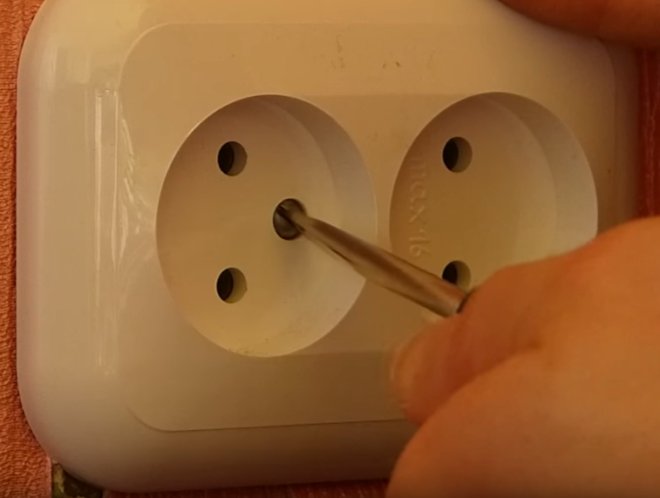
The last steps will be to install the cover, turn on the input machines and check the outlet with a voltage indicator. The check procedure can also be changed - first turn on the machines, check the socket contacts, the efficiency of the grounding (if any) and then install the cover and decorative strip. This is done so that you do not have to turn off the machines again, turn off the power to the apartment and disassemble the outlet if it turns out that there is no contact with the wiring.
The last thing you can check is whether the socket is popping out of the socket. To do this, you just need to insert and remove the plug several times. If there is even the slightest displacement, the fasteners must be revised.
If everything is normal, then your debut as an electrician can be considered complete - the “creative mess” is being eliminated and the replacement of the socket is completed.




